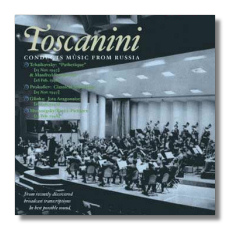
The Internet's Premier Classical Music Source
Related Links
- Latest Reviews
- More Reviews
-
By Composer
-
Collections
DVD & Blu-ray
Books
Concert Reviews
Articles/Interviews
Software
Audio
Search Amazon
Recommended Links
Site News
 CD Review
CD Review
Arturo Toscanini

Conducts Music from Russia
- Piotr Ilyitch Tchaikovsky:
- Symphony #6, "Pathétique"
- Manfred Symphony
- Serge Prokofieff: Symphony #1 "Classical"
- Mikhail Glinka: Jota aragonesa
- Modest Mussorgsky: Pictures at an Exhibition (Orch. Ravel)
Arturo Toscanini, conductor
Music & Arts CD-1115(2) AAD monaural 2CDs 61:50, 76:42
Earlier in the CD era, RCA Victor ambitiously released Toscanini's commercial discography in a 70-volume project that took several years to complete. Then, they started the process all over again with improved remasterings, but only got about one quarter of the way in. Now, with BMG Classics no longer active, RCA barely has a classical program to speak of. Many of the original "Arturo Toscanini Collection" CDs seem to have gone out of print. This is a tragic situation. Fortunately, labels like Music & Arts have retained their sense of duty to our cultural heritage. Although none of the broadcast performances released here have been released commercially until now (these are "recently discovered broadcast transcriptions"), they do fill a gap for those who have not been able to find all of the "authorized" recordings. Furthermore, rabid Toscanini fans will relish the opportunity to compare different performances of the same work, and to argue about which one is the best. (The rest of us can just enjoy the different performances on their own merit!)
No, I am not a "rabid Toscanini fanatic," just a sometimes admirer. Some of his conducting is much too tense and hectic for the music to bear. Take, for example, this Prokofieff "Classical" Symphony, which dates from November 15, 1947. Toscanini's intensity drains the music's parodistic elements, leaving only an unbecoming nervousness – quite the opposite of classical grace. The commercial recording from October 15, 1951 is somewhat more relaxed, particularly in the Larghetto. Similarly, Toscanini invests Glinka's Jota aragonesa with a hell-bent brilliance, both in this performance (February 28, 1948) and in the commercial recording (March 4, 1950). Here, there's little to choose from between the two. The musicianship is exciting as all get out, but don't look for warmth.
Toscanini was more in sympathy with the other three works. The "Pathétique" comes from the same broadcast as the Prokofieff. The familiar commercial recording of this work was made just nine days later. It is no surprise, then, that there are few differences between the two; both readings are unsentimental and free from hysteria. The choice will come down to availability, and to the venues. The RCA version was recorded in Carnegie Hall, where the sound was spacious. The Music & Arts version, recorded in Studio 8-H, is much dryer. With Manfred, a Toscanini favorite, the present broadcast is from the same date as the Glinka; the RCA version is from December 9, 1949. Again, there is not much difference between the two. Toscanini drives the music hard, but he doesn't break its back, and the score's drama blazes forth. (Note that Toscanini made extensive cuts in Manfred – purists be wary!) Availability and sonics are the main issues, exactly as before. Music & Arts's Pictures at an Exhibition comes from Valentine's Day in 1948. Next to the commercial recording from Carnegie Hall (January 26, 1953), one notices that this version, recorded in Studio 8-H, is less well played and also faster. In "Goldenburg and Schmuyle," one can hear the conductor correcting the tempo – a nice "human" touch but not one that necessarily bears repeated listening! It is fun, however, to hear Toscanini "sing" – if one can call it that – during the work's final minute. Overall, when one compares the RCA and Music & Arts performances, the playing of the NBC Symphony Orchestra is consistently better in the former.
The "technical reconstruction" is by Graham Newton. He has done an excellent job, but I must mention that there are inescapable faults in some of the source material. You'll hear thuds and bumps associated with the original transcription discs. Also, the start of Pictures is very noisy, although the noise quickly dissipates.
If you can find the "authorized" releases of these works, you should get them. My margin of preference, however, is not huge, and I have no reservations in recommending the Music & Arts set to members of the two groups I mentioned in the first paragraph.
Copyright © 2003, Raymond Tuttle


















